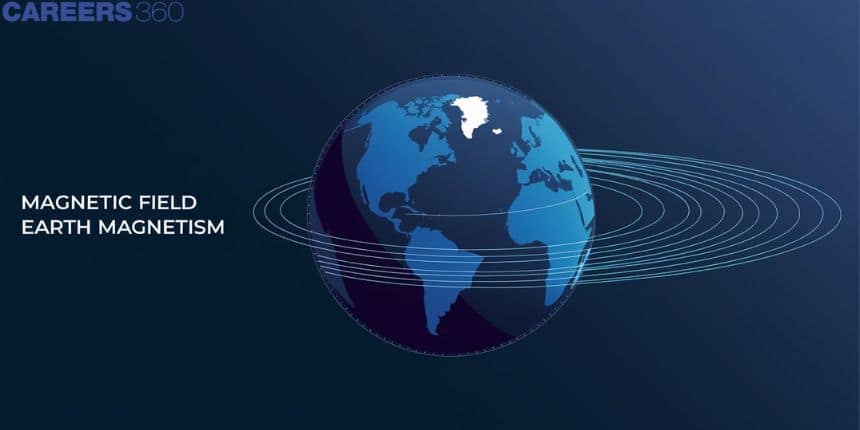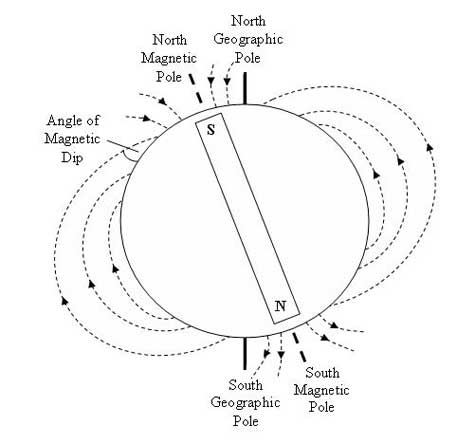Magnetic Field Earth Magnetism - Definition, Cause, Theory, FAQs
A compass is helpful to find the directions and the needle inside the compass always points in the north direction. The compass could be traditionally used as a mechanical compass or inbuilt smartphone component or a refrigerator magnet, all of these points towards the north direction. Do you know why it is so? What's the reason behind it? It is because of Earth’s magnetism. In this article, we will discuss what is the Earth's magnetic field, the components of Earth's magnetic field, the Earth's magnetic poles, the magnetic field of Earth diagram, the Dynamo effect, the horizontal component of Earth magnetic field formula, and equations related to Earth's magnetic field.
This Story also Contains
- What is the Earth's Magnetic Field
- Dynamo Effect - The Cause of Earth Magnetism Class 12
- Earth's Magnetic Poles
- Magnetic Declination
- The Angle of Dip
- Horizontal Component of Earth Magnetic Field Formula
- Equations Related to Earth's Magnetic Field Class 12

What is the Earth's Magnetic Field
The Earth's magnetic field is the magnetic field that surrounds Earth. It is formed due to the Dynamo effect where it is formed by the movement of molten iron and nickel in the outer core. The magnetic field is found to be the component that is similar to a protective layer around the Earth. This magnetic field of the earth does not allow the unwanted charged particles of the sun by repelling and trapping the particles and unwanted wave signals. The magnetic field of the planet is not only present inside the Earth but, also extends for some millions of kilometers outside the Earth's diameter and the whole Earth acts like a bar magnet. The magnetic field has a very weak force compared with other fundamental forces.
Dynamo Effect - The Cause of Earth Magnetism Class 12
The theory which gives a good explanation of the cause of the earth's magnetic system is known as the Dynamo effect. The Dynamo effect explains that the Earth maintains the magnetic field lines on its own due to the metallic fluids that are present in both the outer and inner core of the Earth. Molten iron is present in the outer core and the solidified elements present in the inner core play an important role in the cause of Earth's magnetism.
Some convection currents which are formed by the molten iron and the nickel of the earth's core produce the Earth’s magnetic field. These convection currents carry very few streams of charged particles which causes the magnetic field. The deflection of the magnetic field is caused due to the solar wind caused by the Sun and prevents the entry of these solar winds into our atmosphere. If the magnetic field is removed from the Earth, then these solar winds could destroy the whole Earth, and life would not exist on Earth. The planet Mars lacks these magnetic fields and this is the reason life does not exist on the planet Mars. The magnetic field of Earth diagram is given below.

Earth's Magnetic Poles
The poles of these magnetic fields are inclined by 10 degrees to the rotational axis of the Earth i.e. instead of aligning in the actual geographic north-south direction, the Earth's magnetic pole of the south is present near Canada, and the Earth's magnetic pole of the north is present in Antarctica.
| Related Topics, |
The Components of Earth's Magnetic Field
The magnitude and direction of the earth's magnetism are calculated by using the three major components. The three components are listed below.
- Magnetic declination
- The angle of dip (which is known as magnetic inclination)
- Earth's magnetic field’s horizontal component
Let us discuss the components in detail.
Magnetic Declination
The concept of magnetic declination gives us the angle that lies between the magnetic north and true north. The fact is, this true north does not have a fixed or constant position on the horizontal plane. It varies according to the surface of the earth and time.
The Angle of Dip
The angle of dip is also called magnetic inclination. This magnetic inclination is an angle that is caused by the plane horizontal to the earth’s surface. This magnetic inclination angle is found to be 0 degrees at the magnetic equator of the earth and the magnetic inclination angle at the magnetic poles is found to be 90 degrees.
Horizontal Component of Earth Magnetic Field Formula
The intensity of the magnetic field of the earth breaks into two different components, i.e. horizontal component and a vertical component.
$\tan \bar{\delta}=\frac{\mathrm{B}_{(\mathrm{v})} }{ \mathrm{B}(\mathrm{h})}$
$\sin \bar{\delta}=\frac{B_{(v)} }{ B}$
$\cos \bar{\delta}=\frac{B_{(h)} }{ B}$
$\sin ^2 \bar{ \delta}+\cos ^2 \bar{ \delta}=\frac{B^2_{(\mathrm{v})}}{ \mathrm{B}^2}+\frac{\mathrm{B}_{(\mathrm{h})}^{2} }{\mathrm{B}^2}$
$B=\sqrt{B_{(h)}^2+B_{(v)}^2}$
Where B represents the total magnetic field intensity or strength and is a vector component.
B can be also written as follows.s
$B=\sqrt{X^2+Y^2+Z^2}$
Where, X, Y, and Z represent the components of the magnetic field along the geographic north,
geographic east and vertically downward direction respectively.
X and Y can be found out by using the below formula
$\mathrm{X}=\mathrm{H} \cos \alpha$ and $\mathrm{Y}=\mathrm{H} \sin \alpha$
Where H represents the component of the magnetic field that is parallel to the surface of the earth and this H is equal to $\sqrt{X^2+Y^2}$
The magnetic declination angle (which is known as the angle between true and magnetic north) is denoted by $\alpha$, and this $\alpha$ is equal to $\tan ^{-1}\left(\frac{Y}{X}\right)$. The magnetic inclination angle (which is known as the angle of the horizontal component of the magnetic field) is denoted by $\theta$, and this $\theta$ is equal to $\tan ^{-1}\left(\frac{Z}{H}\right)$.
Equations Related to Earth's Magnetic Field Class 12
| Equation | Formula |
| Magnetic Dip (Inclination) | $\tan I=\frac{B_v}{B_h}$ |
| Total Magnetic Field Strength | $B=\sqrt{B_h^2+B_v^2}$ |
| Magnetic Declination | $D=\theta-\theta_m$ (No fixed formula; location-based) |
| Horizontal Component of Magnetic Field | $B_h=B \cos I$ |
| Vertical Component of Magnetic Field | $B_v=B \sin I$ |
| Gauss's Law for Magnetism | $\oint \mathbf{B} \cdot d \mathbf{A}=0$ |
| Magnetic Potential due to Dipole | $V=\frac{\mu_0 m}{4 \pi r^3}(2 \cos \theta)$ |
| Magnetic Field due to a Dipole (Radial) | $B_r=\frac{\mu_0}{4 \pi} \frac{2 m \cos \theta}{r^3}$ |
| Magnetic Field due to a Dipole (Tangential) | $B_\theta=\frac{\mu_0}{4 \pi} \frac{m \sin \theta}{r^3}$ |
Also read:
Frequently Asked Questions (FAQs)
The value of the component of the earth’s magnetic field which is horizontal is found to be zero.
The earth magnetic field value lies around 25,000 nT to 65,000 nT.
The system of magnetic fields that are covered and surrounded by the atmosphere of the Earth is known as the earth's magnetosphere.
Magnetic compass direction-finding device in which the needle always points to the north direction and helps us to find the direction on Earth.
The deflection of the magnetic field is caused due to the solar wind caused by the Sun and prevents the entry of these solar winds into our atmosphere. If the magnetic field is removed from the Earth, then these solar winds could destroy the whole earth and life would not exist on Earth. This is why the earth requires a magnetic field.
The Dynamo effect tells us that the Earth includes the magnetic field lines on its own due to the metallic fluids which are present in both the outer and inner core of the earth. Molten iron is present in the outer core and the solidified magnetic elements of earth present in the inner core plays an important role in the cause of Earth